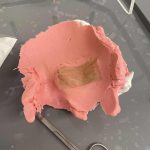My corneal graft unfortunately improved the clarity of my vision in my right eye but, due to my facial palsy, is still prone to drying out. To prevent this and the likelihood of it ulcerating, scarring and dying, I need to cover my eye every night with Glad-wrap – creating a moist and humid environment.
“Yep, glad-wrap doesn’t just keep food FRESH!”
But after over a year of applying this Glad-wrap eye-patch, I finally decided to ditch the plastic and seek the expertise from the prosthetics department.
Many people don’t see my daily eye-patch routine and assume that my eye no longer is such a big issues. However, I have no nerve supply to that eye and my new donor cornea will only dry out and die if I don’t look after it.
It requires ongoing management for the remainder of my life!
So, as you can see from the many images, they initially taped my eye shut to ensure lid closure, paint it with a bubble-gum like putty, then cover it with a white plaster to ensure it retains its shape. Then over the next week they will take a wax mould which will enable them to fabricate the silicon eye-patch.
Phenomenal what they can do!
Often we go through a process, we see the result, but we often don’t realise or see what’s involved in reaching that outcome.To ensure that we all provide better care & don’t feel so alone in the long fabrication process, I think
it’s so helpful to get an understanding of what the entire process will look like. This can be considerations like getting to the appointments, doing trials, getting a brief of what works and what doesn’t and knowing that the solution might take a few tries to get right.
When you’ve developed something, it’s important to remember that it is a trial and there may be other things exposed at each stage or prototype developed in the development process.
If you’re working with someone to develop a new device or treatment, outlining what the entire process will look like and setting the expectations for them on how long it might take will create a sense of calm and understanding in the person. This is so important in providing quality care so the process is smoother for everyone.


I hope that by sharing my story of the process, I’m going through with my eye, it helps you in being able to offer other people care and support that are going through a procedure that might be unclear on expectations.
How can you help someone by being there and asking questions they might not think of? Or helping them brainstorm any issues that may arise during the process? How can you help soak up some of the effort required by the person to reduce their stress?